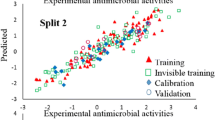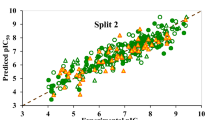Abstract
Reliable prediction of anticancer potential of different substances for different cells using unambiguous algorithms is attractive alternative of experimental investigation of impacts of various anticancer agents to various cells. Quasi-SMILES is a sequence of symbols, which represents all available eclectic data, i.e. not only molecular structure, but also different conditions, which can have influence on examined endpoint (e.g. kinds of cells: human breast; human colon; human liver; human lung). In this work, quasi-SMILES have been used to establish predictive models for anticancer activity isoquinoline quinones related to different cells. Descriptor calculated with optimal correlation weights of different fragments of quasi-SMILES defined by the Monte Carlo technique is used to predict pIC50 as a mathematical function of molecular structure and kinds of cells. The using of the so-called index of ideality of correlation for optimization by the Monte Carlo method improves predictive potential of the model. The statistical quality of the models based on correlation weights of fragments of quasi-SMILES is good. The range of correlation coefficient between experimental and calculated pIC50 for external validation set is 0.76–0.89. The statistical stable promoters for increase and for decrease in pIC50 are established. These models can be used to improve quality of pharmaceutical agents. These computational experiments can be reproduced with available on the Internet software (http://www.insilico.eu/coral).
Graphical abstract



Similar content being viewed by others
References
Aytaç PS, Durmaz I, Houston DR, Çetin-Atalay R, Tozkoparan B (2016) Novel triazolothiadiazines act as potent anticancer agents in liver cancer cells through Akt and ASK-1 proteins. Bioorg Med Chem 24(4):858–872. https://doi.org/10.1016/j.bmc.2016.01.013
Dunn WJ III (1989) Quantitative structure-activity relationships (QSAR). Chemometr Intell Lab Syst 6(3):181–190. https://doi.org/10.1016/0169-7439(89)80083-8
Liu P, Long W (2009) Current mathematical methods used in QSAR/QSPR studies. Int J Mol Sci 10(5):1978–1998. https://doi.org/10.3390/ijms10051978
Doweyko AM (2008) QSAR: Dead or alive? J Comput Aided Mol Des 22(2):81–89. https://doi.org/10.1007/s10822-007-9162-7
Johnson SR (2008) The trouble with QSAR (or how i learned to stop worrying and embrace fallacy). J Chem Inf Model 48(1):25–26. https://doi.org/10.1021/ci700332k
Gobbi M, Beeg M, Toropova MA, Toropov AA, Salmona M (2016) Monte Carlo method for predicting of cardiac toxicity: hERG blocker compounds. Toxicol Lett 250–251:42–46. https://doi.org/10.1016/j.toxlet.2016.04.010
Toropova AP, Toropov AA (2017) Hybrid optimal descriptors as a tool to predict skin sensitization in accordance to OECD principles. Toxicol Lett 275:57–66. https://doi.org/10.1016/j.toxlet.2017.03.023
Toropova AP, Toropov AA (2017) CORAL: binary classifications (active/inactive) for drug-induced liver injury. Toxicol Lett 268:51–57. https://doi.org/10.1016/j.toxlet.2017.01.011
Veselinović JB, Đorđević V, Bogdanović M, Morić I, Veselinović AM (2018) QSAR modeling of dihydrofolate reductase inhibitors as a therapeutic target for multiresistant bacteria. Struct Chem 29(2):541–551. https://doi.org/10.1007/s11224-017-1051-7
Kumar A, Chauhan S (2018) Use of simplified molecular input line entry system and molecular graph based descriptors in prediction and design of pancreatic lipase inhibitors. Future Med Chem 10(13):1603–1622. https://doi.org/10.4155/fmc-2018-0024
Amata E, Marrazzo A, Dichiara M, Modica MN, Salerno L, Prezzavento O, Nastasi G, Rescifina A, Romeo G, Pittalà V (2017) Comprehensive data on a 2D-QSAR model for Heme Oxygenase isoform 1 inhibitors. Data Brief 15:281–299. https://doi.org/10.1016/j.dib.2017.09.036
Rescifina A, Floresta G, Marrazzo A, Parenti C, Prezzavento O, Nastasi G, Dichiara M, Amata E (2017) Development of a Sigma-2 Receptor affinity filter through a Monte Carlo based QSAR analysis. Eur J Pharm Sci 106:94–101. https://doi.org/10.1016/j.ejps.2017.05.061
Rescifina A, Floresta G, Marrazzo A, Parenti C, Prezzavento O, Nastasi G, Dichiara M, Amata E (2017) Sigma-2 receptor ligands QSAR model dataset. Data Brief 13:514–535. https://doi.org/10.1016/j.dib.2017.06.022
Sokolović D, Ranković J, Stanković V, Stefanović R, Karaleić S, Mekić B, Milenković V, Kocić J, Veselinović AM (2017) QSAR study of dipeptidyl peptidase-4 inhibitors based on the Monte Carlo method. Med Chem Res 26(4):796–804. https://doi.org/10.1007/s00044-017-1792-2
Heidari A, Fatemi MH (2017) A theoretical approach to model and predict the adsorption coefficients of some small aromatic molecules on carbon nanotube. J Chin Chem Soc 64(3):289–295. https://doi.org/10.1002/jccs.201600761
Kumar A, Chauhan S (2017) QSAR differential model for prediction of SIRT1 modulation using Monte Carlo method. Drug Res 67(3):156–162. https://doi.org/10.1055/s-0042-119725
Sokolović D, Stanković V, Toskić D, Lilić L, Ranković G, Ranković J, Nedin-Ranković G, Veselinović AM (2016) Monte Carlo-based QSAR modeling of dimeric pyridinium compounds and drug design of new potent acetylcholine esterase inhibitors for potential therapy of myasthenia gravis. Struct Chem 27(5):1511–1519. https://doi.org/10.1007/s11224-016-0776-z
Toropova AP, Toropov AA, Leszczynska D, Leszczynski J (2017) CORAL and nano-QFAR: quantitative feature—activity relationships (QFAR) for bioavailability of nanoparticles (ZnO, CuO, Co3O4, and TiO2). Ecotoxicol Environ Saf 139:404–407. https://doi.org/10.1016/j.ecoenv.2017.01.054
Trinh TX, Choi JS, Jeon H, Byun HG, Yoon TH, Kim J (2018) Quasi-SMILES-based nano-quantitative structure-activity relationship model to predict the cytotoxicity of multiwalled carbon nanotubes to human lung cells. Chem Res Toxicol 31(3):183–190. https://doi.org/10.1021/acs.chemrestox.7b00303
Ni H, Xia C, Zhao Y (2017) Synthesis, cytotoxicity and pro-apoptosis activity of isoquinoline quinones. Med Chem Res 26:2861–2869. https://doi.org/10.1007/s00044-017-1985-8
Toropova AP, Toropov AA, Benfenati E, Leszczynska D, Leszczynski J (2015) QSAR model as a random event: a case of rat toxicity. Bioorg Med Chem 23(6):1223–1230. https://doi.org/10.1016/j.bmc.2015.01.055
Toropov AA, Rasulev BF, Leszczynski J (2008) QSAR modeling of acute toxicity by balance of correlations. Bioorg Med Chem 16(11):5999–6008. https://doi.org/10.1016/j.bmc.2008.04.055
Toropov AA, Toropova AP (2017) The index of ideality of correlation: a criterion of predictive potential of QSPR/QSAR models? Mutat Res, Genet Toxicol Environ Mutagen 819:31–37. https://doi.org/10.1016/j.mrgentox.2017.05.008
Toropova AP, Toropov AA (2017) The index of ideality of correlation: a criterion of predictability of QSAR models for skin permeability? Sci Total Environ 586:466–472. https://doi.org/10.1016/j.scitotenv.2017.01.198
Toropov AA, Carbó-Dorca R, Toropova AP (2018) Index of ideality of correlation: new possibilities to validate QSAR: a case study. Struct Chem 29:33–38. https://doi.org/10.1007/s11224-017-0997-9
Klopman G, Rosenkranz HS (1992) Testing by artificial intelligence: computational alternatives to the determination of mutagenicity. Mutat Res 272:59–71. https://doi.org/10.1016/0165-1161(92)90008-A
Russo M, Santagati NA, Lo Pinto E (1998) Medicinal chemistry and fuzzy logic. J Inf Sci 105:299–314. https://doi.org/10.1016/S0020-0255(97)10034-2
Reisen F, Weisel M, Kriegl JM, Schneider G (2010) Self-organizing fuzzy graphs for structure-based comparison of protein pockets. J Proteome Res 9:6498–6510. https://doi.org/10.1021/pr100719n
Zhang L, Tan J, Han D, Zhu H (2017) From machine learning to deep learning: progress in machine intelligence for rational drug discovery. Drug Discov Today 22:1680–1685. https://doi.org/10.1016/j.drudis.2017.08.010
Bauer FJ, Thomas PC, Fouchard SY, Neunlist SJM (2018) A new classification algorithm based on mechanisms of action. Comput Toxicol 5:8–15. https://doi.org/10.1016/j.comtox.2017.11.001
Hayat S (2017) Computing distance-based topological descriptors of complex chemical networks: new theoretical techniques. Chem Phys Lett 688:51–58. https://doi.org/10.1016/j.cplett.2017.09.055
Kumar S, Kumar P, Marwaha RK, Narasimhan B (2017) Synthesis, antimicrobial evaluation and QSAR studies of propionic acid derivatives. Arab J Chem 10:S881–S893. https://doi.org/10.1016/j.arabjc.2012.12.024
Tebes-Stevens C, Patel JM, Koopmans M, Olmstead J, Hilal SH, Pope N, Weber EJ, Wolfe K (2018) Demonstration of a consensus approach for the calculation of physicochemical properties required for environmental fate assessments. Chemosphere 194:94–106. https://doi.org/10.1016/j.chemosphere.2017.11.137
Yang Y, Lin T, Weng XL, Darr JA, Wang XZ (2011) Data flow modeling, data mining and QSAR in high-throughput discovery of functional nanomaterials. Comput Chem Eng 35:671–678. https://doi.org/10.1016/j.compchemeng.2010.04.018
Urbisch D, Honarvar N, Kolle SN, Mehling A, Ramirez T, Teubner W, Landsiedel R (2016) Peptide reactivity associated with skin sensitization: the QSAR Toolbox and TIMES compared to the DPRA. Toxicol In Vitro 34:194–203. https://doi.org/10.1016/j.tiv.2016.04.005
Acknowledgements
Authors thank the EU Project LIFE-CONCERT (LIFE17 GIE/IT/000461) for financial support.
Author information
Authors and Affiliations
Corresponding author
Electronic supplementary material
Below is the link to the electronic supplementary material.
Rights and permissions
About this article
Cite this article
Toropova, A.P., Toropov, A.A. Quasi-SMILES: quantitative structure–activity relationships to predict anticancer activity. Mol Divers 23, 403–412 (2019). https://doi.org/10.1007/s11030-018-9881-9
Received:
Accepted:
Published:
Issue Date:
DOI: https://doi.org/10.1007/s11030-018-9881-9




